Design & Developed by Themeseye
CAUTION: DAYLIGHT DRIVE SYSTEMS MUST BE DESIGNED AND BUILT BY A QUALIFIED ELECTRICIAN. IMPROPER WIRING AT HIGH VOLTAGES CAN CAUSE ELECTROCUTION OR START A FIRE.
To power heavy loads in a DC Microgrid we wire PV panels directly to DC appliances, with no batteries, inverters or other electronics. A PV supply may power many appliances, which may be operated simultaneously, as solar resources allow. The magic of daylight drive is that many DC motors can operate just fine on a fluctuating power supply. This is not true for AC motors. A power supply of 1kW, for example, may simultaneously operate several DC appliances that have a combined load of over 3kW. The motors might slow down as they share the power, but useful work is done by all of the appliances. An AC-based system, constrained by an inverter and battery capacity, has nothing approaching this level of flexibility.
Generally speaking, daylight drive appliances operate more effectively at high voltages, 90 or 180. (There are a few exceptions to this, like cooking and refrigeration.) Because voltage and wiring requirements are different, a daylight drive system must be wired separately from a 12V battery system. We highly recommend a dedicated PV supply for daylight drive.
Some DC appliances suitable for daylight drive are available on the market, such as DC pumps, fans, and cookers. Daylight drive can also power industrial DC motors connected to belt drive equipment, like old fashioned shop tools and tractor implements.
Because daylight drive appliances only run when the sun is shining, work must be done during the day, or alternative energy storage (like thermal storage, or pressurized water) must be used to provide services at night and during cloudy spells.
Most conventional AC appliances cannot run daylight drive, but there are a few exceptions. These include resistive loads-which make heat, like hot plates for cooking- and universal motors. Likewise, not all DC appliances can run daylight drive, some require a battery to stabilize voltage.
Living Energy Lights offers consulting services for customers interested in building a daylight drive system for their home, business or community.
Most modern solar electric photovoltaic (PV) panels are being manufactured for the “grid-tie” market. That just means that most modern panels have higher voltages than older panels. That’s fine, in fact desirable, from the perspective of using them for daylight drive. Look at the Vmp (voltage maximum power) on the panels that you have or are thinking about getting. For daylight drive, we recommend a target voltage of either 90 – 120 volts or 180 volts. A bit higher or lower is fine. A 90 volt setup would likely involve 3 panels in series, possibly in parallel with 3 more panels in series. A 180 volt setup would likely involve 6 panels in series. Almost all household appliances (not major appliances like heat pumps or heaters) are in the range of a couple hundred watts up to 1500 watts or so. We have a 1400 watt, 180 volt system that has served us well. An minimalist daylight drive system at half that wattage would work for many motors.
A nominal 90 volt PV rack would allow you to run 90 volt industrial brush motors. These are available from many industrial suppliers. A 90 volt system (or up to 120 volt DC) would run some household appliances rated for 120 volts AC. The standard for AC electricity in Europe and Asia is 220 volt AC. Some of those appliances will run with PV power at 180 – 220 volts DC. It is also possible to use a switch and make a solar PV rack put out two different voltages. We do that at LEF, but I don’t recommend it. The simpler approach is that if you live in the U.S., set up a nominal 90 – 120 volt DC system. If you live in a place that has 220 volt appliances, set up a 180 – 220 volt DC system.
Pumping water is the one application where daylight drive is already in common use, particularly for irrigation in the developing world. Several manufacturers offer various types of DC pumps that run just fine daylight drive.
Keep in mind that while many cheap low voltage pumps are available on the market, performance is generally best with more expensive high voltage pumps.
Centrifugal
The pump in most common use these days for rural water systems is a submersible centrifugal pump. A centrifugal pump has an “impeller” inside of it that spins at high speeds. Centrifugal pumps tolerate some dirt, grit, or trash, as long as the particles are not so large as to clog the impeller. They are also well suited for moving high volumes of water. A submersible centrifugal pump is your best choice for irrigation systems with a deep well water source (see scenarios below). Sun Pumps, Grundfos, and Lorentz all offer high voltage, centrifugal submersible DC pumps. We have had great results with Grundfos DC centrifugal pumps for irrigation and domestic water.
Centrifugal pumps have to spin at a minimum speed to pump effectively. They do not tolerate slow moving motors. This means that a certain level of power input (i.e. sunshine) is required for the pump to move any water at all. For this reason, a helical rotor pump might be a better choice when a lower volume of water is needed more consistantly (like for a domestic water supply).
In our experience, the lifetime of a centrifugal pump correlates directly with the number of hours the impeller spends turning. These pumps are not repairable; once they wear out, you need to buy a new one. That said, you can drastically increase the expected working life of your pump if you only turn it on when it is needed, to pressurize storage tanks or irrigate. We recommend a timer on your pump for this purpose.
Positive displacement pumps
Positive displacement is a general term that refers to a number of different kinds of pumps, including:
* diaphragm pumps – available in a wide array of pressure and volume configurations, including expensive submersibles. The advantage of diaphragm pumps is that they have very good pressure output and tolerate a wide range of motor speed. Their big weakness is that they do not tolerate dirt or grit, and generally do not last as long as centrifugal pumps.
* piston pumps – used to be used a lot, but are not so much any more. Just like a piston in an engine moving up and down, the piston in a piston pump physically pushes liquid through the pump. Piston pumps tolerate variable speed. (There are some very expensive modern piston pumps on the market that can be tied straight to PV panels and tolerate the varying speed in PV output through a day). Piston pumps are variable in how much dirt and grit they tolerate, usually a bit more then diaphragm pumps, but not as much as centrifugal pumps. Old piston pumps are available as well. We have used them some as daylight drive irrigation pumps at LEF to pump creek water.
* helical rotor – Lorentz and Grundfos also make helical rotor submersibles. Excellent pressure performance even at low power, so this pump is well suited to the floating power supply of daylight drive. Dirt/ grit resistance is probably not quite as good as centrifugal, but that assertion is not based on experience. Pressure trades off with volume, so this is pump is not the best choice for irrigation systems that require high volumes.

All surface pumps are subject to freezing in winter. Freezing can easily shatter a pump beyond repair.
Brushless motors are more expensive than brush motors. With ANY DC MOTOR or pump, if it does not say “brushless,” then it is a brush motor. Brush motors need occasional maintenance. Brush motors are fine in your shop where the motors are easily accessible. They are not so good at the bottom of a deep well, unless cost considerations force you to buy cheap equipment.
All water pumps push much better than they pull. That is the reason there is so much standardization to submersible pumps. The reason is that water is much thicker (much higher viscosity) than air. Air is very spongy and soft compared to water. If a pump is above the water source, the distance from the water to the pump is the lift. Almost all pumps have very limited lift. The distance from the pump to the maximum height that a pump will push water is the feet of head, which is convertible to PSI — 1 PSI = 2.31 feet of head. Generally speaking, you are always better off with the pump at the lowest point. It’s easy to push water. It’s really difficult to lift springy air and pull water up into the pump.
1) Deep Well Water, Consistent Pressure Primary Consideration
A) Highest cost, best performance – Helical rotor, pressure performance would be similar to an AC pump, good pressure at varying power levels. Cost is $2500 or so.
B) Lower cost – Sun pumps and a number of other pump companies make submersible diaphragm pumps. They do not last as long as the more expensive pumps, but they are cheaper. Robison also makes a low-flow submersible piston pump that is limited to 50 feet depth of water that is a bit cheaper.
2) Deep Well Water, Volume and Durability Primary Considerations
A) Highest cost, best performance – high voltage submersible centrifugal pumps by Sun Pumps, Lorentz, or Grundfos. Performance is great in all conditions except very low power. Cost is $2000 +.
B) Lower cost – Cheaper brush motor pumps by Sun Pumps or other companies.
3) Shallow Well
A) Highest cost, best performance – submersibles are still the best. Considerations as per above.
B) Lower cost – Various “shallow well” pumps have been used over the years, including centrifugal and piston pumps. The centrifugal pumps are generally “direct coupled” from pump to motor, which makes conversion to DC more difficult. The old piston pumps work, but they tend to by leaky and “loosing prime” (when air gets in the pump) is a perpetual headache. Jet pumps are also used, but those are also all direct coupled.
C) Cheapest option — There are some very cheap submersible, low-voltage DC pumps available (Chinese manufacture on Ebay), but these aren’t likely to last long at all. If the lift is very short, you might be able to use a surface mount diaphragm or piston pump.
4) Surface Water/ Irrigation, Clean, Low Head (High Pressure Output Not Needed)
A) Highest cost, best performance – submersibles are still the best. Considerations as per above.
B) Lower Cost – Diaphragm or piston pumps. Cheap diaphragm pumps are available (12 and 24 Volt) for use in connection with sprayer units on trucks and what not. Provided the water is clean, durability is not bad.
5) Surface Water/ Irrigation, Dirty Water, Low Head (High Pressure Output Not Needed)
If you have dirty water you are trying to pump for irrigation, you really have little choice but a centrifugal pump. For DC motor conversion, belt-driven pumps (aka pedestal pumps) are easiest to convert. Pedestal pumps used to be common, but not so much any more. Used ones are easy to find. Beware, a single-stage centrifugal pump will have little lift or head.
If you are planning to use a daylight drive pump for domestic water supply, you need to install some sort of storage to have water pressure whenever the sun doesn’t shine (at night and during cloudy spells). A water tower is one option, but an easier option is to install one or more air bladder tank. These are in common use for any rural water system, and therefore are readily available. We recommend installing approximately 40 gallons of storage per person, or more. Keep in mind that with any amount of storage, you will need to be careful with your water use whenever the sun isn’t shining.
Most rural homes have a 20 – 30 gallon water storage tank, and rely on a pump that can run anytime of the day or night to supply water. Normal off-grid design relies on many thousands of dollars of electrical hardware to run conventional AC pumps at night. At LEF, we have 3 tanks like the one above, 120 gallons each. These tanks are not free, but overall system costs are much lower than conventional design.
Many DC refrigerators are available on the market, but most are designed to run through a battery bank. Just a few models are designed to run daylight drive. One of these models is Sundanzer DDR. We have years of experience with this model and recommend it highly. Unfortunately, as of early 2022 all suppliers of this model are out of stock. We are actively looking into alternatives for the Sundanzer, and will update when we find one.
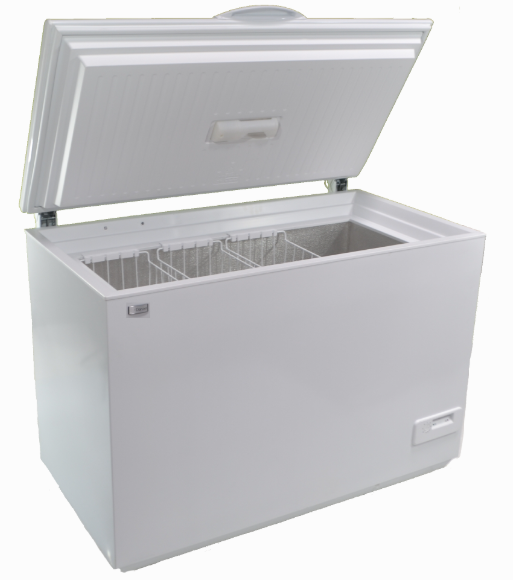
The best way to use daylight drive for cooking is with ISECs (Insulated Solar Electric Cookers) like the Roxy Oven. The insulation allows you to leverage your wattage into more heat, meaning you can do more cooking with a smaller PV supply. For reference, a typical electric range uses 5,000-10,000 watts. A single burner, or hot plate, might use 1,200 watts. Our Roxy oven is designed for around 325 watts.
It also works well to power an ISEC as part of an integrated daylight drive system where a PV supply is shared with many other appliances. At Living Energy Farm we built a 1,400 watt daylight drive system which powers many appliances, including a high capacity ISEC with three power settings: high (1,400w), medium (700w), and low (300w). We’re able to cook and bake a lot of food using the low and medium settings, while simultaneously running several high wattage appliances like a pump, heating blowers, shop tools, etc.
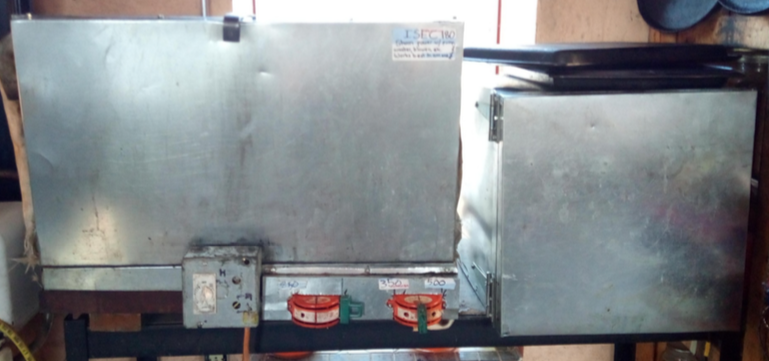
In an integrated daylight drive system of 700-1,500 watts, it might be practical to use some uninsulated solar electric cooking, when extra power is available. Any resistive heating element made from nichrome, which includes almost all electric ovens and hot plates, will run as well on DC as it runs on AC. DC electricity tends to heat up connections more than AC, and switches and other electronic controls will not tolerate DC. So it’s important to bypass any AC switches or controls, and wire directly to the heating element, using an external switch. (See wiring, switches and breakers.)
There are several options for running fans with daylight drive. There are also many 12V fans available on the market that are compatible with our battery kits, like this one. These fans are small, not intended to move large volumes of air. For ventilation, winnowing, and other applications that require high air flow, we recommend daylight drive.
A commercially available option is DC fans from snap-fan.com, which offers several models suitable for daylight drive and battery backed systems.
At LEF, we built two winnowing fans by mounting a fan blade directly on a 180V industrial DC motor. These fans run without any electronic speed controls, therefore the airflow fluctuates with the sun. If you build your own fan, be sure to include an adequate safety cage around the blade.
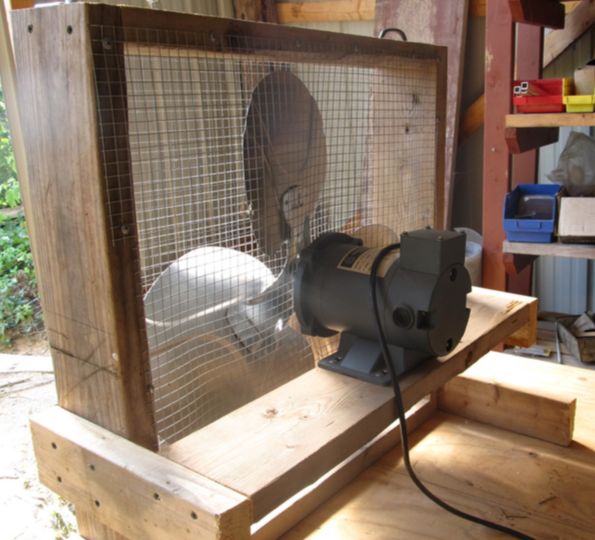
Many household appliances that run on AC do not actually have AC motors, rather they have “universal” motors that will run on AC or DC. Universal motors made for the American market are designed for 120V AC, but will run just fine on a PV supply that is nominal 90V, as actual voltage will run higher in full sun. We are mindful to run our universal motors only in strong solar conditions.
Universal motors are high-powered, lightweight motors. Portable appliances often have them. All corded power saws, drills, angle grinders, and similar shop tools have universal motors. Other lightweight household appliances such as vacuum cleaners and blenders, also have universal motors. If you can look into the motor while it is running and see blue sparks inside, then it is almost certainly a universal motor and can run DC.
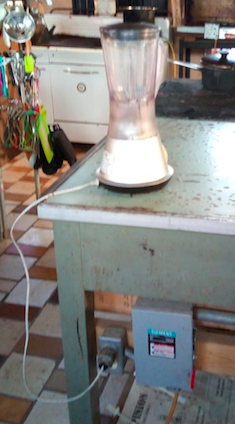
Beware, DC electricity generates a lot of heat in switches. We replace normal switches with very heavy switches to run DC. In some cases, we simply tape the trigger switch on the tool and use the heavy switch next to the receptacle. Other times we re-wire the appliance to bypass the switches. With power tools in particular, THIS MAKES THE TOOL MORE DANGEROUS TO OPERATE BECAUS YOU DO NOT HAVE THE INSTANT OFF YOU HAVE WITH A TRIGGER SWITCH. With an angle grinder, blender or shop vac, the risk is not so bad.
For continuous and/or heavy loads, belt drive equipment and industrial DC permanent magnet motors are your best bet. These motors are widely available at a number of different standard voltages. For most household scale daylight drive systems, standardizing to 90V makes the most sense.
There are many industrial DC motors on the market. Higher quality DC motors are available from Leeson, Baldor, and Sun Pumps. They are pricey, but also often available more cheaply on Ebay. Chinese industrial DC brush motors mostly work okay. Small DC motors, such as scooter motors, are cheaper. The quality of those motors is more variable. With larger motors, brush motors are fine. With small motors, it’s better to use brushless on any equipment that is going to be heavily used.
At LEF we operate belt drive tools and industrial DC motors for many purposes, including:
-a Grainmaker mill for flour, meal, and peanut butter
-metalworking shop tools including a drill press, lythe, mill, grinder, band saw, and compressor
-a buzz saw (firewood saw made to run off tractor PTO)
-blowers for drying seeds at ambient temperatures
-blowers moving heated air, for active space heating
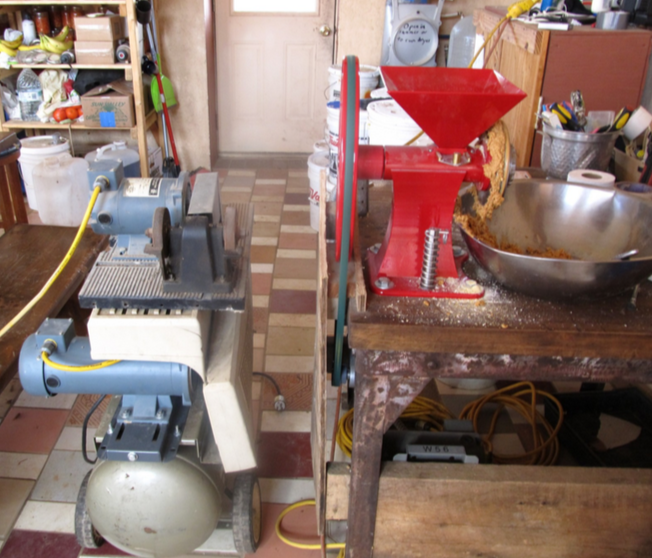
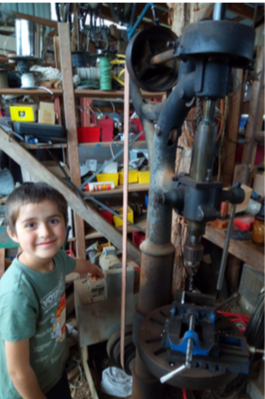
Once again, DAYLIGHT DRIVE SYSTEMS MUST BE DESIGNED AND BUILT BY A QUALIFIED ELECTRICIAN. IMPROPER WIRING AT HIGH VOLTAGES CAN CAUSE ELECTROCUTION OR START A FIRE.
A 90V daylight drive system should be wired to code in a similar fashion as 120V AC system in terms of grounding, wire sizing, and boxes. DC systems use different breakers than AC systems. DC systems also need different switches. DC tends to arc across weak connections much more than AC. This can result in weak connections corroding more quickly with DC. It also means that DC power can quickly corrode the contacts on lightweight switches. Much heavier switches are required for high voltage DC than high voltage AC when powering heavy loads. For lights that use little power, AC switches work fine for DC.
Some DC appliances, like refrigerators, have electronic controls that can be damaged by a surge during a thunderstorm. We recommend protecting these devices with a surge arrestor. Quality surge arrestors for solar applications are available through Midnite Solar and Delta.